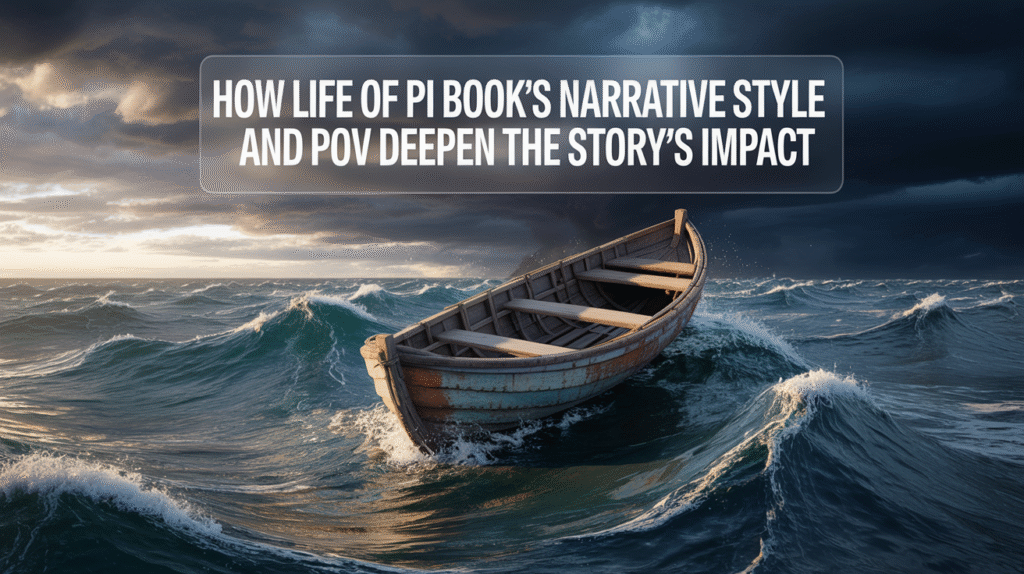Life of Pi uses a unique blend of narrative styles and points of view that profoundly shape the reader’s understanding of the story. These storytelling techniques don’t just relay events, they frame how we experience truth, faith, and survival.

Here’s a breakdown of how Yann Martel’s narrative choices add layers of meaning to the novel.
The Framed Narrative: A Story Within a Story
Life of Pi is structured as a story within a story, using a layered narrative that adds credibility and emotional depth.
The Author as a Character
- The fictional version of Yann Martel introduces the story, acting as a curious writer who interviews Pi.
- This metafictional technique blurs the lines between fiction and nonfiction, making the story feel more authentic.
Pi’s Story Told in Retrospect
- The bulk of the novel is narrated by an older Pi, recounting his survival story from years ago.
- This retrospective view allows mature reflection, emotional distance, and deeper philosophical commentary.
First-Person POV: Personal and Immersive
The majority of the book is told in Pi’s first-person voice, pulling readers directly into his mind.
Direct Access to Pi’s Emotions
- Readers experience fear, faith, confusion, and hope exactly as Pi does.
- This intimacy makes his journey feel raw and believable, even when it ventures into the surreal.
Unreliable Yet Compelling
- Because Pi is telling his own story, readers must question the accuracy of his recollection.
- His poetic and sometimes vague language enhances the ambiguity of what really happened.
Shifts in Perspective: A Strategic Change in Voice
Martel occasionally switches point of view, particularly when the “author” or other characters provide their input.
The Author’s Framing Voice
- This narrative layer interrupts Pi’s account with observations, offering skepticism or curiosity.
- It gives readers space to pause and question what they’re hearing.
The Japanese Investigators
- At the end of the novel, the POV briefly switches to a transcript format from the Japanese shipping investigators.
- This sudden shift to a factual, objective tone contrasts sharply with Pi’s lyrical storytelling, reinforcing the theme of multiple truths.
Language Style: Lyrical, Philosophical, and Vivid
The tone and language style in Life of Pi play a critical role in crafting its atmosphere and philosophical weight.
Poetic Descriptions
- Martel’s writing often uses rich metaphors and symbolic language to describe nature, faith, and suffering.
- This elevates mundane survival into something mythic and transcendent.
Philosophical Digressions
- Pi frequently reflects on religion, morality, and storytelling itself.
- These introspective moments add thematic depth and break up the tension of survival scenes.
Thematic Use of Narrative Style
The choice of narrative structure in Life of Pi is tightly connected to its central themes of truth, belief, and storytelling.
Storytelling as Survival
- Pi’s elaborate narrative may be a coping mechanism—crafting a palatable version of trauma.
- The act of telling a story becomes an act of emotional and psychological endurance.
Subjective Truth vs Objective Reality
- The dual narratives (one with animals, one without) are a product of Pi’s control over the story.
- Martel invites readers to pick the version they prefer, asking, “Which is the better story?”
Reader Involvement: Making the Audience a Participant
The narrative technique in Life of Pi engages the reader as an active participant in meaning-making.
Choosing Your Version of the Story
- By offering two interpretations, the book makes the reader responsible for assigning truth.
- This decision reflects on the reader’s own beliefs about religion, fiction, and reality.
Playing with Trust
- The blend of poetic prose, first-person voice, and metafiction challenges the reader’s instincts.
- Is Pi manipulating us—or just doing his best to convey something true in a deeper sense?
FAQ: Narrative Style and POV in Life of Pi
Here are some questions and answers about how narrative structure shapes Life of Pi.
What point of view is Life of Pi written in?
The novel uses a combination of first-person (Pi’s account) and a fictionalized third-person authorial perspective. Most of the story is narrated by Pi himself.
Why does the author use a framed narrative?
The framed narrative adds realism and distance. It sets up Life of Pi as a tale discovered and retold, enhancing its mythical and testimonial qualities.
How does the narrative style affect the theme of truth?
By offering layered voices and two versions of the story, the narrative style emphasizes the theme that truth is often a matter of perspective and belief.
Is Pi a reliable narrator?
That’s intentionally left ambiguous. His vivid imagination, trauma, and deep faith suggest he might alter reality for comfort or survival—but that doesn’t make his story meaningless.
Why include the Japanese investigators at the end?
The investigators provide a contrasting, factual lens. Their dry perspective enhances the emotional and symbolic weight of Pi’s narrative and underscores the theme of subjective truth.
The narrative structure and point of view in Life of Pi are not just stylistic choices—they are essential to the novel’s exploration of belief, truth, and storytelling. They transform a survival story into a profound philosophical experience.
